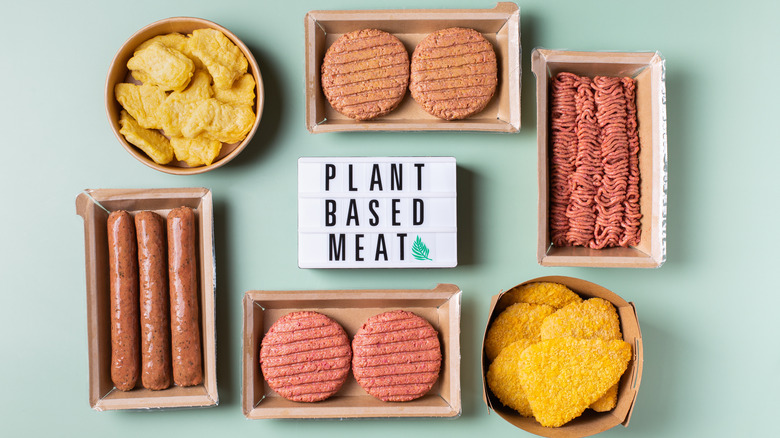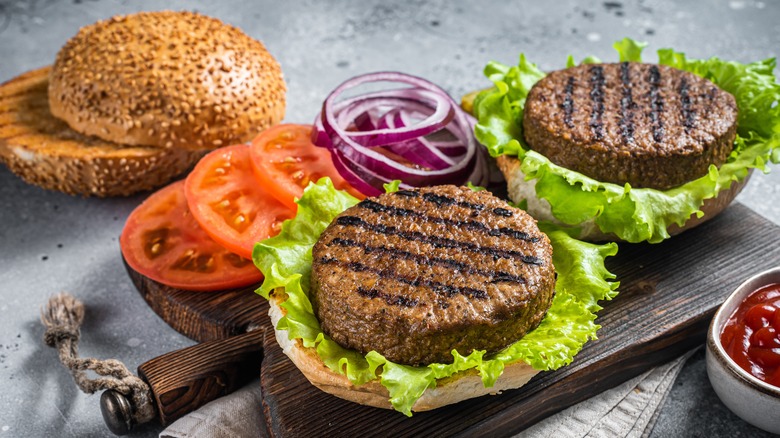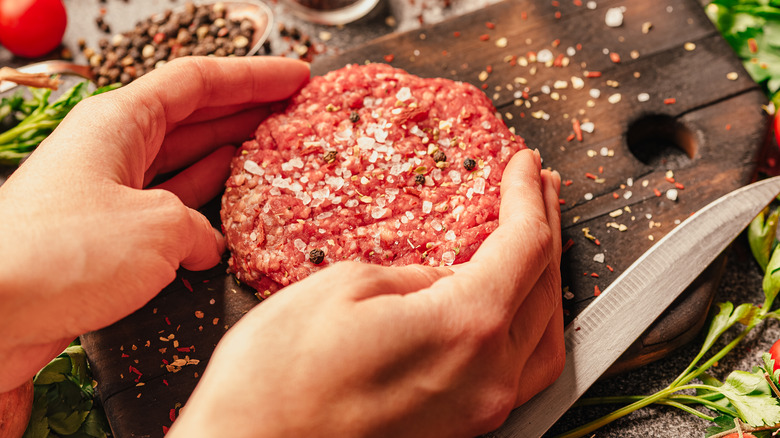Why You Need To Stop Cooking Plant-Based Meat Like Real Meat
When it comes to plant-based meat, throw everything you know about cooking meat out of the window. Although plant-based meat may eerily look like the real thing, they couldn't be any more different when it comes to cooking them.
The plant-based meat industry is thriving and is forecast to grow 20% annually through 2030, according to Grand View Research. There are now plant-based alternatives for beef patties, chicken nuggets, and ground meat. Arguably, the most recognizable brands are Impossible Food and Beyond Meat; they have their own lines of meatless beef, chicken, and pork products that can be found in grocery stores and online.
With so many meatless meat options, it can be quite confusing how to properly cook them. The major reason you shouldn't cook plant-based meat like actual meat boils down to the ingredients. Plant-based meat tends to be more sticky than its counterpart due to legumes, such as peas, and potato starch (via Food & Wine). Impossible burger patties are typically made of soy protein (via Impossible Food), while Beyond Burger patties are made of pea and rice proteins (via Beyond Meat).
When cooking any meat — real or not — it's important to cook them at the proper temperature to ensure safety. Cooking them at the right temperature will also yield the best texture and taste.
The perfect temperature to cook plant-based meat
Plant-based meats, especially Impossible Food and Beyond Meat products, tend to brown faster than real meat (via The New York Times). Thus, cooking them at the right temperature will prevent under and overcooking.
Wonder how plant-based meats are able to replicate the texture of real meat? Both Impossible Food and Beyond Meat patties contain coconut oil that mimics real meat's fat and the "sizzle" when cooking meat (via Impossible Food and Beyond Meat). Cooking your meat at the precise temperature, however, will help get the plant-based meat to a close meat-like texture and a golden-brown sear.
According to America's Test Kitchen, 130 degrees is the ideal temperature to cook plant-based meats for a "tender, juicy" texture. Cooking them at 125 degrees will result in a sad "mushy and pasty" taste and cooking them too high (160 degrees) turns the meat "bouncy" and "chewy." Plant-based meats also cook faster than real meat, per America's Test Kitchen. If you are cooking meatless patties, the recommended cooking time for burger patties is two to three minutes on each side.
Don't be afraid to over-season
Unlike actual meat, there's no such thing as over-seasoning plant-based meats. Adding seasoning simply elevates the flavor of the dish, like umami, for example. Umami, a Japanese word that roughly translates to "essence of deliciousness," is one of the five basic tastes defined as a "rich, meaty flavor," according to Delish. Adding umami-rich ingredients, like mushrooms, soy sauce, miso paste, or even MSG to plant-based meat or dishes can enhance its flavor (via Epicurious). If you don't have these ingredients laying around in the kitchen, simple spices, such as smoked salt, paprika, or cumin work wonders for adding a little umami.
However, America's Test Kitchen warns against over-salting plant-based meats. Although you would typically salt real meat, plant-based meats already contain salt. In fact, a typical plant-based patty contains 370 mg of salt; a beef patty contains just about 80 mg (via Fueled By Science). Despite being lower than the recommended daily intake, America's Test Kitchen encourages using ¼ teaspoon less salt when cooking plant-based beef versus real meat.


